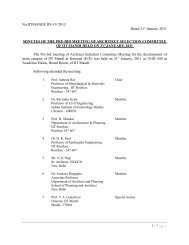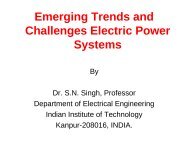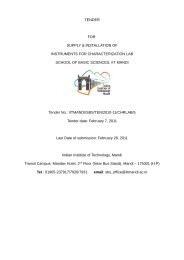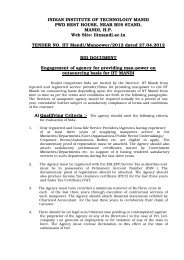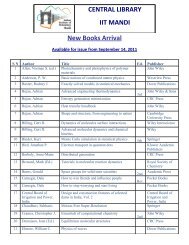Issue1. Vol.1 (April, 2013) - IIT Mandi
Issue1. Vol.1 (April, 2013) - IIT Mandi
Issue1. Vol.1 (April, 2013) - IIT Mandi
- No tags were found...
You also want an ePaper? Increase the reach of your titles
YUMPU automatically turns print PDFs into web optimized ePapers that Google loves.
ESSENT Society for Collaborative Research and Innovation, <strong>IIT</strong> <strong>Mandi</strong>Thermo-physicalmodeling of Laser-Therapy for CancerDr.Niraj Sinha, Assistant Professor,School of Engineering, <strong>IIT</strong> <strong>Mandi</strong>.Dr. Sinha has received his PhD from Universityof Waterloo and has worked as post doctoralfellow at Massachusetts Institute of Technology.His research interests are in the areas ofmanufacturing, materials science,nanotechnology and bioengineering.andDr. Ankit Bansal, Assistant ProfessorSchool of Engineering, <strong>IIT</strong> <strong>Mandi</strong>Dr. Bansal has received his PhD in MechanicalEngineering from the Pennsylvania StateUniversity.Dr. Bansal specializes in radiative heat transferand spectral modeling of radiative properties inthermal plasma. He is currently involved inStochastic modeling of infectious disease andradiative heat transfer for applications relatedto cancer treatment.Cancer is the most common malignancy withover 10.9 million people diagnosed each yearworldwide. Approximately 60% of cancerpatients go through radiation therapy as a meansof the treatment. If the radiation is deliveredfrom outside the body, photon energies ofseveral million electron volts are needed toreach deep-seated tumours. Use of high intensitydoses may damage healthy tissues laterally.Delivering radiation dose only to cancerouscells is a great challenge in the radiationtherapy. An ideal strategy for improvement ofradiotherapeutic efficacy against human canceris to effectively deliver radiosensitizer to targettumours cells, causing preferentially increasedtumour cytotoxicity, while simultaneouslyprotecting normal tissues and organs. It has beenfound that the dose delivered to a tumour duringphoton-based radiation therapy can be enhancedby loading high atomic number (Z) materialsinto the tumour. To this end, radiosenstitizationusing gold nanoparticles (AuNPs) seems a verypromising approach for radiotherapy as they arebiologically inert and because nanoparticles(NPs) can more easily penetrate the tumourvasculature.Heat Transfer in Biological Tissue withExternal IrradiationIn radiotherapy, tissue or tumour cells areirradiated with a collimated or convergingradiation source. The radiation source can beeither collimated or focusing. The collimatedradiation beam requires high power and longexposure time to sufficiently achieve the desiredeffect. This leads to significant heat diffusionwhich will damage the surrounding healthytissue. In contrast, the converging beam couldpenetrate a greater depth and significantlyincrease the incident power at the target,avoiding undesirable reactions in thesurrounding healthy tissues. Nanoparticlesattached to the tissue cells absorb the radiationenergy and gets heated. Long laser pulses–withpulse duration exceeding the thermal relaxationtime–cause heating of the surrounding mediumalong with the nanoparticles, as heat diffusesacross the particle boundary. On the other hand,23 ESSENT|Issue1|Vol1




